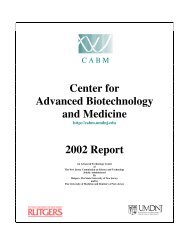Annual Report 2011 - Center for Advanced Biotechnology and ...
Annual Report 2011 - Center for Advanced Biotechnology and ...
Annual Report 2011 - Center for Advanced Biotechnology and ...
You also want an ePaper? Increase the reach of your titles
YUMPU automatically turns print PDFs into web optimized ePapers that Google loves.
Dr. Vikas N<strong>and</strong>a<br />
CABM Resident Faculty Member<br />
Associate Professor<br />
Department of Biochemistry<br />
UMDNJ-Robert Wood Johnson<br />
Medical School<br />
Dr. Fei Xu<br />
Research Associate<br />
Dr. Agustina<br />
Rodriguez-Granillo<br />
Research Assistant<br />
Dr. James Stapleton<br />
Postdoctoral Fellow<br />
Dr. Isaac John Khan<br />
Postdoctoral Assoc.<br />
Dr. Avanish Parmar<br />
Postdoctoral Assoc.<br />
Sumana Giddu<br />
Research Teaching Spec.<br />
Teresita Silva<br />
Research Teaching Spec.<br />
Daniel Hsieh<br />
Graduate Student<br />
Protein Design <strong>and</strong> Evolution Laboratory<br />
Dr. Vikas N<strong>and</strong>a joined CABM in September of 2005 after studying as an<br />
NIH National Research Service Award postdoctoral fellow in the laboratory<br />
of Dr. William DeGrado at the Department of Biochemistry <strong>and</strong> Biophysics<br />
at the University of Pennsylvania School of Medicine. His research focused<br />
on studying the molecular basis of transmembrane interactions among<br />
integrins involved in regulation of platelet hemostasis. Prior to that, Dr.<br />
N<strong>and</strong>a received his doctorate in Biochemistry from Johns Hopkins<br />
University. His laboratory is supported by federal grants including a recent<br />
highly competitive NIH New Innovator Award.<br />
.<br />
Our group is interested in constructing new proteins <strong>for</strong> applications in biomedical<br />
research, nanotechnology <strong>and</strong> as tools <strong>for</strong> underst<strong>and</strong>ing how proteins fold <strong>and</strong><br />
evolve. Significant progress has been made in the last decade using sophisticated<br />
computer programs to design proteins with novel folds <strong>and</strong> functions. We maintain<br />
<strong>and</strong> develop the software package, protCAD (protein computer aided molecular<br />
design), which has been applied to protein design, structure prediction <strong>and</strong> docking<br />
of protein lig<strong>and</strong> complexes.<br />
Computational Design of an Extracellular Matrix<br />
The extracellular matrix (ECM) is a complex network of collagens, laminins,<br />
fibronectins <strong>and</strong> proteoglycans that provides a surface upon which cells can adhere,<br />
differentiate <strong>and</strong> proliferate. Defects in the ECM are the underlying cause of a wide<br />
spectrum of diseases. The ECM mediates endothelial cell polarity <strong>and</strong> under normal<br />
conditions can suppress pre-oncogenic transitions to a neoplastic state. We are<br />
constructing artificial, de novo collagen-based matrices using a hierarchic<br />
computational approach. These matrices will be physically characterized in the<br />
laboratory <strong>and</strong> used to probe the role of chemical <strong>and</strong> spatial organization in the<br />
ECM on the tumor <strong>for</strong>ming potential of adhered cells. Successfully designed<br />
matrices will be applied to engineering safer artificial tissues.<br />
Rational Design of Enhanced Peptide Therapeutics<br />
Peptides are an emergent <strong>and</strong> important class of therapeutics with over <strong>for</strong>ty<br />
compounds on the market <strong>and</strong> nearly 700 more in clinical or pre-clinical trials.<br />
During the development of peptide drugs, D-enantiomers of amino acids are<br />
frequently incorporated to improve pharmacokinetic <strong>and</strong> pharmacodynamics<br />
62



